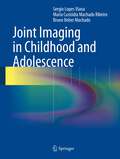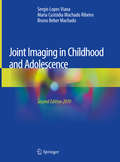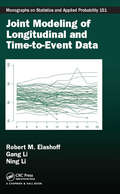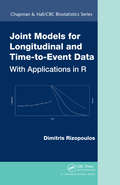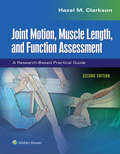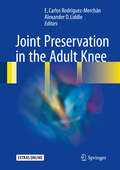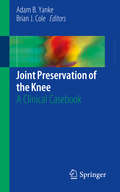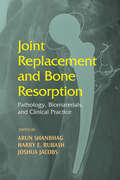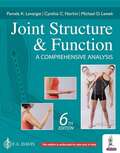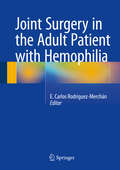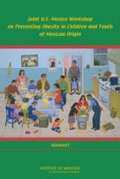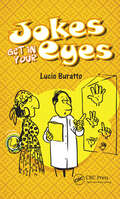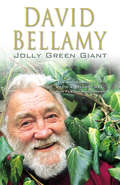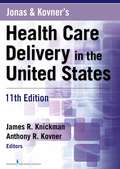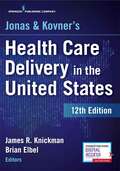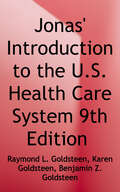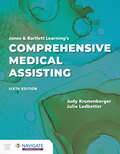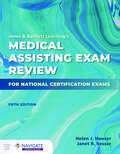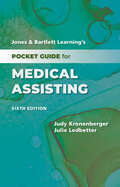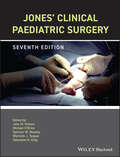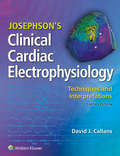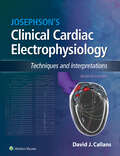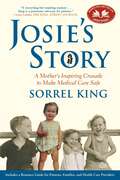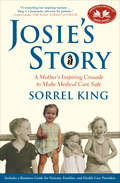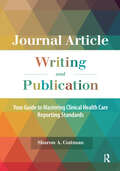- Table View
- List View
Joint Imaging in Childhood and Adolescence
by Bruno Beber Machado Maria Custódia Machado Ribeiro Sergio Lopes VianaKnowledge of the imaging appearances of the immature joint is crucial for correct image interpretation, yet this is a relatively neglected subject in the literature and in training. This book presents the essential information on imaging of the immature joint with the aim of providing radiologists (musculoskeletal specialists and generalists alike) and other specialists with a new tool that will assist greatly in overcoming the daily challenges posed by interpretation of pediatric examinations in the twenty-first century. The opening chapters consider the current role, advantages, and limitations of each modality in pediatric assessment and present the imaging appearances of anatomic and developmental peculiarities of the growing skeleton. Findings in a wide range of important conditions are then described in a series of richly illustrated chapters that present appearances on diverse imaging studies, from conventional radiography through to modern high-tech modalities.
Joint Imaging in Childhood and Adolescence
by Bruno Beber Machado Maria Custódia Machado Ribeiro Sergio Lopes VianaKnowledge of the imaging appearances of the immature joint is crucial for correct image interpretation, yet this is a relatively neglected subject in the literature and in training. This book presents the essential information on imaging of the immature joint with the aim of providing radiologists (musculoskeletal specialists and generalists alike) and other specialists with a new tool that will assist greatly in overcoming the daily challenges posed by interpretation of pediatric examinations in the twenty-first century. The opening chapters consider the current role, advantages, and limitations of each modality in pediatric assessment and present the imaging appearances of anatomic and developmental peculiarities of the growing skeleton. Findings in a wide range of important conditions are then described in a series of richly illustrated chapters that present appearances on diverse imaging studies, from conventional radiography through to modern high-tech modalities.
Joint Modeling of Longitudinal and Time-to-Event Data (Chapman & Hall/CRC Monographs on Statistics and Applied Probability #151)
by Ning Li Robert Elashoff Gang liLongitudinal studies often incur several problems that challenge standard statistical methods for data analysis. These problems include non-ignorable missing data in longitudinal measurements of one or more response variables, informative observation times of longitudinal data, and survival analysis with intermittently measured time-dependent covariates that are subject to measurement error and/or substantial biological variation. Joint modeling of longitudinal and time-to-event data has emerged as a novel approach to handle these issues. Joint Modeling of Longitudinal and Time-to-Event Data provides a systematic introduction and review of state-of-the-art statistical methodology in this active research field. The methods are illustrated by real data examples from a wide range of clinical research topics. A collection of data sets and software for practical implementation of the joint modeling methodologies are available through the book website. This book serves as a reference book for scientific investigators who need to analyze longitudinal and/or survival data, as well as researchers developing methodology in this field. It may also be used as a textbook for a graduate level course in biostatistics or statistics.
Joint Models for Longitudinal and Time-to-Event Data: With Applications in R (Chapman & Hall/CRC Biostatistics Series #Vol. 6)
by Dimitris RizopoulosIn longitudinal studies it is often of interest to investigate how a marker that is repeatedly measured in time is associated with a time to an event of interest, e.g., prostate cancer studies where longitudinal PSA level measurements are collected in conjunction with the time-to-recurrence. Joint Models for Longitudinal and Time-to-Event Data: Wit
Joint Motion, Muscle Length, and Function Assessment: A Research-Based Practical Guide
by Hazel ClarksonNow in striking full color, this updated edition of Clarkson’s Joint Motion, Muscle Length, and Function Assessment: A Research-Based Practical Guide offers an accessible and comprehensive presentation of the clinical evaluation and functional application of joint range of motion. Throughout the book, easy-to understand discussions of different types of goniometers, alternate methods of assessment, the reliability and validity of other joint ROM tools, and contraindications and precautions prepare students for effective practice. A clear and concise writing style, outstanding illustration program, and built-in learning aids, including case studies, chapter objectives, and practical examination forms, make this an ideal resource for future physical and occupational therapists.
Joint Preservation in the Adult Knee
by E. Carlos Rodríguez-Merchán Alexander D. LiddleThis book offers a comprehensive overview of the basic science and clinical evidence for non-arthroplasty interventions in the adult knee. It aims to cover all aspects of joint-preserving knee surgery, from injectable therapies such as platelet-rich plasma and stem cell therapies to surgical interventions such as meniscal repair and replacement, ligament reconstructions, and osteotomies. Following discussion of clinical assessment and imaging, individual chapters focus on specific clinical problems, including patellofemoral joint disorders, chondral injuries, and bone tumors. For each condition, a thorough overview is provided, describing clinical assessment, management (including surgical and non-surgical methods), and novel therapies. The contributors are experts in their fields from across Europe and are drawn from the worlds of clinical and academic orthopedic surgery. This book is unique in its coverage of the entire span of non-arthroplasty knee surgery and its focus on both clinical and basic science aspects. It will be helpful for knee surgeons and those engaged in research on knee-related topics, but also for students and other physicians involved in the care of patients with disorders of the knee.
Joint Preservation of the Knee: A Clinical Casebook
by Adam B. Yanke Brian J. ColeComprised of clinical cases demonstrating strategies for both common and complex knee preservation, this concise, practical casebook will provide orthopedic surgeons with the best real-world strategies to properly manage the many kinds of knee injuries and disorders they may encounter. The opening section presents the knee joint as a unique structure, reviewing the anatomy and function of articular cartilage and the meniscus, the effects of joint malalignment, the role of the synovium, and how joint failure is defined. The next two sections are comprised of clinical cases with a unique presentation, followed by a description of the diagnosis, assessment and management techniques used to treat it, as well as the case outcome, and clinical pearls and pitfalls. Cases included illustrate small and large cartilage defects, osteochondritis dessicans, chondral defects and lesions, meniscal allograft transplantation, and tibial and tibiofemoral cartilage defects, among others. The final section examines the current evidence for the treatment of articular cartilage lesions and emerging techniques in knee joint preservation and cartilage restoration.Pragmatic and reader-friendly, Joint Preservation of the Knee: A Clinical Casebook is an excellent resource for orthopedic surgeons and sports medicine specialists treating common and complex injuries of the knee.
Joint Replacement and Bone Resorption: Pathology, Biomaterials and Clinical Practice
by Joshua J. Jacobs Arun Shanbhag Harry E. RubashThis first guide devoted to this burgeoning topic, this authoritative reference presents the current understanding of the phenomenon of aseptic loosening of total joint replacements from the molecular and cellular mechanisms of periprosthetic bone loss to the clinical presentation and management strategies-reviewing the properties of ceramic, metal
Joint Structure and Function: A Comprehensive Analysis
by Pamela K. Levangie Cynthia C. Norkin Michael D. LewekJOINT STRUCTURE & FUNCTION A COMPREHENSIVE ANALYSIs
Joint Surgery in the Adult Patient with Hemophilia
by E. Carlos Rodríguez-MerchánThis book provides clear instruction on the surgical treatment of joint problems in adult hemophilia patients. The procedures applicable to specific joints, including the shoulder, elbow, hip, knee and ankle, are carefully reviewed with the aid of high-quality illustrations. The surgical treatment of articular hemophilic pseudotumors and bone cysts is also considered. In addition, clinically relevant information is provided on a range of topics, such as the treatment of hemophilic hemarthrosis, the imaging of hemophilic joints, hematological perioperative management, anesthesia, rehabilitation and pharmacoeconomics. Finally, the controversial issues of postoperative thromboembolic prophylaxis and the role of COX-2 inhibitors in hemophiliacs are reviewed. The guidance provided draws on both the authors' extensive personal experience and an in-depth review of the pertinent literature. The book offers an excellent, up-to-date account of knowledge on musculoskeletal problems and approaches to joint surgery in adults with hemophilia. It will be of value to orthopedic surgeons, rehabilitation physicians, hematologists, radiologists and pharmacy researchers.
Joint U.S.-Mexico Workshop on Preventing Obesity in Children and Youth of Mexican Origin: SUMMARY
by Institute of Medicine of the National Academies6 16The Joint U.S.-Mexico Workshop on Preventing Obesity in Children and Youth of Mexican Origin was initiated by a desire to share experiences regarding the problem of obesity in children and youth of Mexican origin on both sides of the border, with a particular focus on potential solutions. U.S and Mexican researchers, public health officials, industry leaders, and policy-makers engaged in valuable dialogue to share perspectives, challenges, and opportunities. Commonalities and differences in the United States and Mexico regarding risk factors, potential interventions and programs, and need for all sectors to collaborate and make progress toward solving this serious public health problem were also discussed. This dialogue served as a basis to explore a bi-national agenda for addressing this epidemic, which was the ultimate goal of the workshop.
Jokes Get in Your Eyes
by Lucio BurattoOphthalmologists encounter patients every day, some who will be facing difficult and extremely delicate surgical procedures. As the physician-patient relationship begins and the ophthalmologist is working to properly diagnose, treat and manage the patient’s condition, they must also play a role in reducing patient anxiety and tension.Inside the pages of Jokes Get in Your Eyes, Dr. Lucio Buratto brings a lighter side to the ophthalmology profession. Sometimes a smile can be the first step to reducing patient anxiety and tension. Sometimes laughter can be therapeutic. Jokes Get in Your Eyes contains 40 Jokes and 80 cartoon illustrations—all in a pocket size handbook that can easily fit into a lab coat pocket. Reading thru Jokes Get in Your Eyes, ophthalmologists will be able to bring a smile to their day, as well share a joke or two among colleagues.From the Foreword:With his latest book, Jokes Get in Your Eyes, it is amazing that he was able to accumulate so many jokes related to the eyes. It is refreshing to have a physician who is so well rounded.”-Robert M. Sinskey, MD, Jules Stein Eye Institute, University of California at Los Angeles
Jolly Green Giant
by David BellamyDavid Bellamy is a natural story teller whose memoir will be packed full of funny anecdotes and observations. It is the story of how a city boy, brought up in the middle of London, went for a trip into the countryside one day, an event which was to transform his life by setting in motion the amazing love of nature which would make famous this larger-than-life character. In his infectious style he illumines on, amongst other things, the fact that his father, the manager of a branch of Boots, had to grease his hair straight - because in those days managers of Boots weren't allowed to have curly hair! Then there was the time he and his brother discovered an exploded bomb, kept in the garden shed - and then accidentally blew off the front of the house with it. He reveals his secret passion is ballet dancing - and how his mother only found out about it when she saw him on stage at the Fairfield Hall in Croydon. His career as an academic, then author, broadcaster, consultant and television personality, spans 35 years and his main passion - campaigning for the environment - have led to many adventures including his being twice imprisoned in the Third World.
Jonas And Kovner's Health Care Delivery In The United States
by Anthony R. Kovner James R. KnickmanDesigned for graduate and advanced undergraduate students of health care management and administration and public health, the text addresses all of the complex core issues surrounding our health care system in a strikingly readable and accessible format. Contributors provide an in-depth and objective appraisal of why and how we organize health care the way we do, the enormous impact of health-related behaviors on the structure, function, and cost of the health care delivery system, and other emerging and recurrent issues in health policy, health care management, and public health.
Jonas And Kovner's Health Care Delivery In The United States
by Brian Elbel James KnickmanJonas and Kovner's Health Care Delivery in the United States is a highly acclaimed textbook on health care delivery, and has been fully updated and revised. The 12th edition of this well regarded US health care textbook provides graduate and undergraduate students with a comprehensive survey of health care in the United States with topics ranging from the organization of care, the politics surrounding health care in the United States, to population health and vulnerable populations, health care costs and value, health care financing, and health information technology. Chapters provide thorough coverage of the rapid changes that are reshaping our US healthcare system and the extent of our nation’s achievement of health care value and the Triple Aim: better health and better care at a lower cost. With an emphasis on population health and public health, this text includes a timely focus on how social and physical environments influence health outcomes. Prominent scholars, practitioners, and educators within public health, population health management, health policy, healthcare management, medical care, and nursing present the most up-to-date evidence-based information on social and behavioral determinants of health and health equity, immigrant health, health care workforce challenges, preventive medicine, innovative approaches to control healthcare costs, initiatives to achieve high quality and value-based care, and much more. Designed for graduate and advanced undergraduate students of healthcare management and administration, nursing, and public health, the text addresses all complex core issues surrounding our US health care system and health policy, such as the challenges to health care delivery, the organization and politics of care, and comparative health systems. Organized in a readable and accessible format, contributors provide an in-depth and objective appraisal of why and how we organize health care the way we do, the enormous impact of health-related behaviors on the structure, function, and cost of the health care delivery system, and other emerging and recurrent issues in health policy, health care management, and public health. The 12th edition of Jonas and Kovner's Health Care Delivery in the United States features the contributions of such luminaries as former editor Anthony R. Kovner, Michael K. Gusmano, Carolyn M. Clancy, Marc N. Gourevitch, Joanne Spetz, James Morone, Karen DeSalvo, and Christy Harris Lemak, among others. Chapters include audio chapter summaries with discussion of newsworthy topics, learning objectives, discussion questions, case exercises, and new charts and tables with concrete health care data. Included for instructors are an Instructor’s Manual, PowerPoint slides, Syllabus, Test Bank, Image Bank, supplemental e-chapter on A Visual Overview of Health Care Delivery, access to an annual ACA update and health policy changes, extra cases and syllabus specifically for nurses, and a transition guide bridging the 11th and 12th editions.
Jonas' Introduction to the U. S. Health Care System, Ninth Edition
by Raymond L. Goldsteen Karen Goldsteen Benjamin Z. GoldsteenThis revised ninth edition of the best-selling introductory text to the U.S. health care system is fully updated to reflect changes to health care services, delivery, and financing resulting from new policies affecting the Affordable Care Act (ACA). Valued for its concise and balanced survey of the U.S. health care system, this book describes how the American health care system currently functions, the major factors that led to its present day structure, and a forecasting of how the industry is likely to change over the course of the next few years. This practical text highlights an array of influences shaping the future of health care, such as the use of big data and analytics, new policies and trends tied to pharmaceuticals and medical devices, and innovations to mental health and substance abuse. With an emphasis on policy development, the authors underscore the fluidity of the system and examine the debates and conflicts that have shaped health care changes and influenced American values and belief systems. This accessible text defines the most essential elements of the health care system, including its components, organization, services, and financing. An ideal text for undergraduate courses, graduate survey courses, and courses introducing the subject to medical students, it describes the ongoing evolution of the system, taking into consideration future directions given proposed changes to the ACA and other health laws by Congress, the Trump administration, and the political landscape in general. Organized to facilitate an understanding of concepts at work, Jonas’ Introduction to the U.S. Health Care System equips public health and health administration students as well as medical, nursing, and allied health professionals with a deeper understanding of the field in which they will practice, so they can position themselves to navigate upcoming changes that affect health care quality, value, and access.
Jones & Bartlett Learning's Comprehensive Medical Assisting
by Judy Kronenberger Julie LedbetterDesigned to ensure that every medical assisting graduate can quickly trade a cap and gown for a set of scrubs, Jones & Bartlett Learning's Comprehensive Medical Assisting, Sixth Edition is more than just a textbook - it’s an engaging, dynamic suite of learning resources designed to train medical assisting students in the administrative and clinical skills they’ll need in today’s rapidly changing health care environment. This edition has been updated to include the most current American Association of Medical Assistants (AAMA) curriculum standards for medical assistants in all three domains: cognitive, psychomotor, and affective. These standards are required for the Commission on Accreditation of Allied Health Education Programs (CAAHEP)-accredited programs.
Jones & Bartlett Learning's Medical Assisting Exam Review for National Certification Exams
by Helen Houser Janet SesserWatch Helen Houser, RN, MSHA and Janet Sesser, BS, CMA provide an overview on how to use the new edition of Jones & Bartlett Learning's Medical Assisting Exam Review for National Certification Exams.This fifth edition of Jones & Bartlett Learning's Medical Assisting Exam Review for National Certification Exams provides a capstone review for soon-to-be graduated, recent graduates, and working medical assistants who are preparing to take a national certification exam. Take advantage of a unique approach that uses a pretest with analysis to help users identify their strengths and weaknesses and develop their own personalized study plan to streamline review and practice. This proven book is packed with study smart resources, including more than 2,000 questions and six timed, simulated exams available online, as well as study tips and exam-taking strategies. The book's user-friendly design follows a simple outline format to make the information easy to digest, and we have sequenced topics so they build on each other.Every new print copy includes Navigate Premier Access that unlocks a complete, interactive eBook, student practice activities, Anatomy & Physiology module, audio glossary, and more! A proven quick-reference format features questions, answers, and rationales on the same page to eliminate wasting time flipping back and forthAn updated bookmark with key medical abbreviations and definitions is included for covering the answersNew and expanded information is provided on emergencies, compliance, Meaningful Use and ICD 10, and moreWhat exam takers should know about immunizations, VAERS, VISs, and vaccine storageCritical Thinking Case Review at the end of each chapter with critical thinking questions related to the case A pretest with analysis helps users determine their individual strong and weak areas so they can focus their study on what they still need to masterTest preparation tips are provided for users for whom English is their second languageInformation useful for study groups, along with exam-taking strategies and exam-day preparation tips are includedTestPrep simulating the CCMA, CMA (AAMA), RMA (AMT), and NCMA national exam questions for students Important review terms with definitions are supported by online flashcards and an audio glossaryNEW! Chapter on final knowledge check with additional practice questions © 2023 | 470 pages
Jones & Bartlett Learning's Pocket Guide for Medical Assisting
by Judy Kronenberger Julie LedbetterJones & Bartlett Learning's Pocket Guide for Medical Assisting provides the essential information you need to make the transition from the classroom to the clinic as smooth and as stress-free as possible. The streamlined, quick-reference format allows you to easily find key information to carry out clinical, administrative, and laboratory duties. It keeps all the essential information at hand and organized for easy review and is the ideal procedure manual every medical assistant needs for the practice setting. Color-coded tabs to clearly identify sections"Warning" boxes describe situations that may pose an increased risk to you or your patient "Charting Examples" present realistic samples of the information required for legal documentationVital reference material includes commonly prescribed medications, normal lab values, pain assessment tools, HIPAA resources, key English-to-Spanish health care phrases, a basic medical terminology refresher, commonly used abbreviations, Celsius-Fahrenheit conversions, metric equivalents, and more © 2024 | 266 pages
Jones' Clinical Paediatric Surgery
by Michael O'Brien John M. Hutson Sebastian K. King Warwick J. Teague Spencer W. BeasleyJones' Clinical Paediatric Surgery provides clear-sighted advice on the surgical options available for young patients.Building on the popular and successful style of previous editions, this fully revised seventh edition employs a systematic approach to the childhood diseases that need surgical treatment. It includes more case vignettes and colour photographs, expanded coverage on the use of imaging, and updated approaches to management including laparoscopic operations. Key subject areas are supported by case vignettes in a familiar format similar to what might appear in an OSCE viva.Jones' Clinical Paediatric Surgery is the ideal guide for paeditricians, surgeons and trainees, as well as primary care physicians, junior doctors and medical students.
Josephson's Clinical Cardiac Electrophysiology: Techniques and Interpretations
by David CallansWidely known as the premier electrophysiology text, Josephson’s Clinical Cardiac Electrophysiology provides a thorough understanding of the mechanisms of cardiac arrhythmias and the therapeutic interventions used to treat them. Dr. David J. Callans, personally chosen and trained by Dr. Mark Josephson, continues the tradition of excellence of previous editions while bringing the text fully up to date in every area of this complex field. The sixth edition provides highly visual guidance on the electrophysiologic methodology required to define the mechanism and site of origin of arrhythmia – enabling you to choose the safest and most effective therapy for each patient.
Josephson's Clinical Cardiac Electrophysiology: Techniques and Interpretations
by David CallansWidely regarded as the premier text in this complex field, Josephson’s Clinical Cardiac Electrophysiology, Seventh Edition, provides a thorough understanding of the mechanisms of cardiac arrhythmias and the therapeutic interventions used to treat them. Dr. David J. Callans, personally chosen and trained by Dr. Mark Josephson, provides expert clinical insights and superb illustrations that highlight proven approaches and methods. With its strong focus on physiologic investigation and its role in clinical decision making, this comprehensive text is a must-have reference for cardiology fellows, electrophysiologists, and others in the EP lab.
Josie's Story
by Sorrel KingSorrel King was a 32-year-old mother of four when her eighteen-month-old daughter, Josie, was horribly burned by water from a faulty water heater in the family's new Baltimore home. She was taken to Johns Hopkins--renowned as one of the best hospitals in the world--and Sorrel stayed in the hospital with Josie day-in and day-out until she had almost completely recovered. Just before her discharge, however, she was erroneously injected with methadone, and died soon after. Sorrel's account of her unlikely path from grieving parent to nationally renowned advocate is interwoven with descriptions of her and her family's slow but steady road to recovery, and ends with a deeply affecting description of a ski trip they took recently. The sun is shining, her children are healthy, and they are all profoundly happy--a condition that Sorrel has learned to appreciate all the more for Josie. The book ends with a resource guide for patients, their families, and healthcare providers; it includes information about how to best manage a hospital stay and how to handle a medical error if one does occur.
Josie's Story: A Mother's Inspiring Crusade to Make Medical Care Safe
by Sorrel KingSorrel King was a 32-year-old mother of four when her eighteen-month-old daughter, Josie, was horribly burned by water from a faulty water heater in the family’s new Baltimore home. She was taken to Johns Hopkins?renowned as one of the best hospitals in the world?and Sorrel stayed in the hospital with Josie day-in and day-out until she had almost completely recovered. Just before her discharge, however, Sorrel noticed something was wrong Josie was looking pale, she appeared severely dehydrated, and her eyes were rolling back in her head. Sorrel pleaded with the doctors and nurses (many of whom she had become close to) that something was wrong, and they agreed to stop administering Josie methadone, the narcotic they were using to wean her off morphine. Josie had begun noticeably improving when a new nurse approached her with a syringe of methadone. When Sorrel tried to stop her from administering the drug, the nurse said that the orders had been changed again. Sorrel, against her better judgment, decided that Hopkins must know best, and stepped back. Almost as soon as the drug had been injected into Josie’s system, she went into cardiac arrest. The doctors raced to save her, but by the time they stabilized her, Josie was brain dead, her organs shutting down one by one. She passed away shortly thereafter, her family having made the choice to take her off life support. In the days and months that followed, Sorrel went through the tumultuous processes of grieving. For a while, she thought she would not survive; suicide and alcohol both seemed like viable escape possibilities, and Sorrel toyed with both. But ultimately it was her rage that kept her alive rage at the doctors, at Hopkins, and at the medical institution that had allowed this to happen. She wanted the doctors to feel the same pain she had caused them. She wanted to destroy Hopkins brick by brick.” Dizzy with grief, she came close to ending her marriage, but slowly pulled herself and her life back together, for the sake of her family, and for the memory of Josie. It was around this time that Sorrel learned a staggering fact though indeed an error, Josie’s death wasn’t a fluke in the statistical sense of the word. About 98,000 American patients die a year as the result of medical error, making it the fourth most prevalent cause of death in the US. Armed with this fact, the money from her settlement with Hopkins, and a vague awareness that Josie’s death could have been prevented, Sorrel began to penetrate the healthcare industry. An appearance on Good Morning America and a long article in the Baltimore Sun raised the public profiles of her and her mission, while speaking requests began to pour in from hospitals and healthcare groups across the world. For the most part, medical errors had simply not been talked about; most doctors involved in them were paralyzed by remorse and fear of lawsuits, while the patients were dead or badly injured and their families crippled by grief. Sorrel was helping to pull back the curtain on an all-too-common killer, and the world of healthcare knew it. Despite some initial resistance, most in the industry came to welcome her message, and to look to her for answers. With the help of other patient safety advocates many of them doctors, and some of them the very Hopkins officials who had defended the hospital after Josie’s death Sorrel and The Josie King Foundation began to develop and implement in hospitals basic programs that emphasize communication, respect of the patient, and attentiveness to their concerns. Rapid Response Teams, for instance, can be called from the beside by patients or their families who feel they are experiencing a serious change in their condition that is not getting sufficient attention from hospital floor staff. A team made up of doctors, nurses and a patient relations coordinator responds quickly to evaluate the patient and develop a plan for care. This is just one example of a program that came out of Sorrel’s...
Journal Article Writing and Publication: Your Guide to Mastering Clinical Health Care Reporting Standards
by Sharon A. GutmanThe ability to demonstrate that a specific health care profession provides valuable and effective services that meet society’s health needs is a major objective for all health care academicians and researchers. Such skills are critical to ensure service reimbursement from an increasingly small pool of health care dollars. Demonstrating clinical effectiveness depends on the reporting of written research results through journal publication so that the health care community and larger society will be able to access and read evidence supporting health care services. Today, several clinical reporting standard guidelines have been created by researchers to enhance the ability of readers to evaluate the quality and value of studies. Journal Article Writing and Publication is the first text to compile those clinical research reporting standards in one source and helps educators and novice researchers to better understand the skills needed for journal publication. Health care researchers must begin using these reporting standards in order to write manuscripts that are both correctly formatted and transparently convey all critical study strengths and limitations. Educators must teach these reporting standards to students who must evaluate research reports as consumers and possible future contributors to the literature through their own writing.Journal Article Writing and Publication by Dr. Sharon A. Gutman (a former editor of the American Journal of Occupational Therapy) provides specific guidelines, based on the most commonly accepted reporting standards, for the preparation and writing of general research studies, intervention effectiveness studies, instrument development and testing studies, and case reports. A section is devoted to helping authors understand the rules governing the reporting of statistical data in text and tables. Separate sections help authors understand the manuscript preparation and submission process, the revision process, and the etiquette guiding communication with editors and reviewers. Guidelines for the preparation of scholarly discussion papers and editorials are also provided.Journal Article Writing and Publication also features a section that aims to help doctoral students and newly minted faculty turn academic work and dissertations into publishable journal articles. Suggestions are provided to help clinicians turn clinical data into research databases that could serve as the foundation for pilot studies. Finally, information is provided to help authors better understand the ethical considerations of publication including plagiarism, dual submissions, inappropriate authorship, copyright, and conflict of interest.
